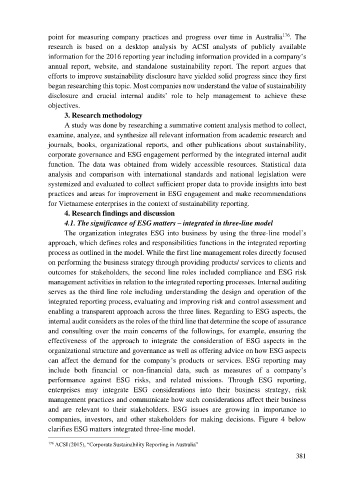Page 389 - Ebook HTKH 2024
P. 389
point for measuring company practices and progress over time in Australia . The
176
research is based on a desktop analysis by ACSI analysts of publicly available
information for the 2016 reporting year including information provided in a company’s
annual report, website, and standalone sustainability report. The report argues that
efforts to improve sustainability disclosure have yielded solid progress since they first
began researching this topic. Most companies now understand the value of sustainability
disclosure and crucial internal audits’ role to help management to achieve these
objectives.
3. Research methodology
A study was done by researching a summative content analysis method to collect,
examine, analyze, and synthesize all relevant information from academic research and
journals, books, organizational reports, and other publications about sustainability,
corporate governance and ESG engagement performed by the integrated internal audit
function. The data was obtained from widely accessible resources. Statistical data
analysis and comparison with international standards and national legislation were
systemized and evaluated to collect sufficient proper data to provide insights into best
practices and areas for improvement in ESG engagement and make recommendations
for Vietnamese enterprises in the context of sustainability reporting.
4. Research findings and discussion
4.1. The significance of ESG matters – integrated in three-line model
The organization integrates ESG into business by using the three-line model’s
approach, which defines roles and responsibilities functions in the integrated reporting
process as outlined in the model. While the first line management roles directly focused
on performing the business strategy through providing products/ services to clients and
outcomes for stakeholders, the second line roles included compliance and ESG risk
management activities in relation to the integrated reporting processes. Internal auditing
serves as the third line role including understanding the design and operation of the
integrated reporting process, evaluating and improving risk and control assessment and
enabling a transparent approach across the three lines. Regarding to ESG aspects, the
internal audit considers as the roles of the third line that determine the scope of assurance
and consulting over the main concerns of the followings, for example, ensuring the
effectiveness of the approach to integrate the consideration of ESG aspects in the
organizational structure and governance as well as offering advice on how ESG aspects
can affect the demand for the company’s products or services. ESG reporting may
include both financial or non-financial data, such as measures of a company’s
performance against ESG risks, and related missions. Through ESG reporting,
enterprises may integrate ESG considerations into their business strategy, risk
management practices and communicate how such considerations affect their business
and are relevant to their stakeholders. ESG issues are growing in importance to
companies, investors, and other stakeholders for making decisions. Figure 4 below
clarifies ESG matters integrated three-line model.
176 ACSI (2015), “Corporate Sustainability Reporting in Australia”
381

